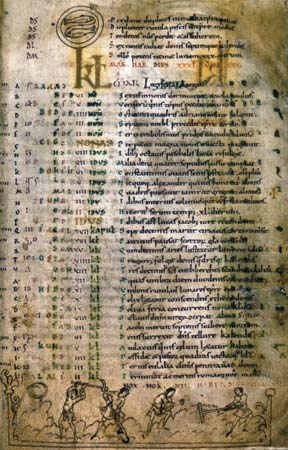Julian calendar
chronology
also called Old Style calendar
 dating system established by Julius Caesar (Caesar, Julius) as a reform of the Roman republican calendar. By the 40s BC the Roman civic calendar was three months ahead of the solar calendar. Caesar, advised by the Alexandrian astronomer Sosigenes (Sosigenes Of Alexandria), introduced the Egyptian solar calendar, taking the length of the solar year as 365 1/4 days. The year was divided into 12 months (month), all of which had either 30 or 31 days except February, which contained 28 days in common (365 day) years and 29 in every fourth year (a leap year, of 366 days). Leap years repeated February 23; there was no February 29 in the Julian calendar. To align the civic and solar calendars, Caesar added days to 46 BC, so that it contained 445 days. Because of misunderstandings, the calendar was not established in smooth operation until AD 8.
dating system established by Julius Caesar (Caesar, Julius) as a reform of the Roman republican calendar. By the 40s BC the Roman civic calendar was three months ahead of the solar calendar. Caesar, advised by the Alexandrian astronomer Sosigenes (Sosigenes Of Alexandria), introduced the Egyptian solar calendar, taking the length of the solar year as 365 1/4 days. The year was divided into 12 months (month), all of which had either 30 or 31 days except February, which contained 28 days in common (365 day) years and 29 in every fourth year (a leap year, of 366 days). Leap years repeated February 23; there was no February 29 in the Julian calendar. To align the civic and solar calendars, Caesar added days to 46 BC, so that it contained 445 days. Because of misunderstandings, the calendar was not established in smooth operation until AD 8.Sosigenes had overestimated the length of the year by 11 minutes 14 seconds, and by the mid-1500s the cumulative effect of this error had shifted the dates of the seasons by about 10 days from Caesar's time. Pope Gregory XIII's reform (see Gregorian calendar), proclaimed in 1582, restored the calendar to the seasonal dates of AD 325, an adjustment of 10 days. The Julian calendar has gradually been abandoned since 1582 in favour of the Gregorian calendar. Great Britain changed to the Gregorian calendar in 1752. The Greek (Eastern Orthodoxy) and Russian Orthodox (Russian Orthodox church) Christian churches have continued to use the Julian calendar for their liturgical year.
- Tirol avalanches of 1916
- TIROS
- Tirpitz, Alfred von
- Tirso de Molina
- Tirthankara
- Tiruchchirappalli
- Tirukkural
- Tirunelveli
- Tirupati
- Tiruppur
- Tiruvalluvar
- Tiryns
- Tischbein, Johann Heinrich Wilhelm
- Tischendorf, Konstantin von
- Tiselius, Arne
- Tisha be-Av
- Tiso, Jozef
- Tissaphernes
- Tisserand, Félix
- Tissot, James
- tissue
- Tissue Affected by Phosphoinositide Second
- tissue culture
- tissue engineering
- Tista River